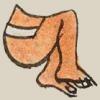tzintli (Mdz25r)
This element, serving as the diminutive suffix (-tzin), has been carved from the compound sign for the place name, Amiltzinco. In that compound it was a phonogram, but here we are including it as a logogram. It shows the lower half of a man's body, seated, with knees together and upright. The body is bare, except for the belt of a loincloth, and the feet are bare. He is shown sitting up, in profile, facing toward the viewer's right.
Stephanie Wood
The phonetic component -tzin- comes from the word for buttocks, tzintli, here shown as a man's rear end, given that we can see the white belt of the loincloth.
Stephanie Wood
c. 1541, but by 1553 at the latest
Stephanie Wood
butts, buttocks, rear end, little, lower, bottom, nalgas, trasero

tzin(tli), buttocks, https://nahuatl.wired-humanities.org/content/tzintli
-tzin, new, little, lower, or reverential, https://nahuatl.wired-humanities.org/content/tzin
buttocks or diminutive, reverential
las nalgas, el ano; diminutivo o reverencial
Stephanie Wood
Codex Mendoza, folio 25 recto, https://digital.bodleian.ox.ac.uk/objects/2fea788e-2aa2-4f08-b6d9-648c00..., image 60 of 188.
The Bodleian Libraries, University of Oxford, hold the original manuscript, the MS. Arch. Selden. A. 1. This image is published here under the UK Creative Commons, “Attribution-NonCommercial-ShareAlike 3.0 License” (CC-BY-NC-SA 3.0).


